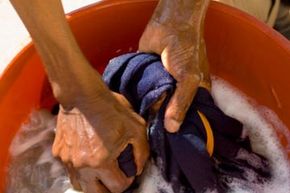Key Takeaways
- Hand-washing is necessary for delicate and expensive garments that may be damaged by machine washing.
- Key tips include using a clean sink, cool to lukewarm water and mild soap specifically designed for hand-washing or delicates.
- Gentle swishing and thorough rinsing are crucial. Dry the garments flat to maintain their shape.
Today, you usually say "washboard" when referring to someone's abdominal muscles. But prior to the 1900s, hand-washing laundry, using washboards or not, was the only way to go. No wonder people dreaded the Monday wash day and washed clothes as little as possible. Thankfully, we now have machines to take care of our washing but there are still some items that require us to use manual labor.
It's usually the more delicate and often expensive clothes that require hand-washing -- sometimes it's in the garment's directions; other times, we just decide not to risk it in the washing machine. But before you get started, let's discuss some do's and don'ts:
Advertisement
- Believe the Hype: Hand-washing and machine washing, even on the gentle cycle are different. The agitation on the gentle cycle may stretch, snag or pull fabrics. A front load machine will have less agitation, but regardless, hand-washing is not equivalent to your delicate cycle.
- Read your Labels: If a label reads "dry clean only," proceed with caution. This may mean water will damage that fabric or agitation is bad for the piece. If you decide to hand-wash it, you're taking a chance, so if the item is irreplaceable or expensive, decide if it's worth it.
- Know your Fabric: Good candidates for hand-washing are usually solid colors, cashmere, some silks, and some woolens. Fabrics like velvet or taffeta are better left to dry cleaning. An example is Dupioni silk, a silk woven from two different silkworms. With washing, Dupioni shrinks, loses stiffness and sheen..
- Lighten your Load: While a good solution when traveling, hand-washing doesn't work well on heavy items like towels or jeans. Rinsing alone will use more water than a machine. Save it for "unmentionables" or a few items at once.
Advertisement

